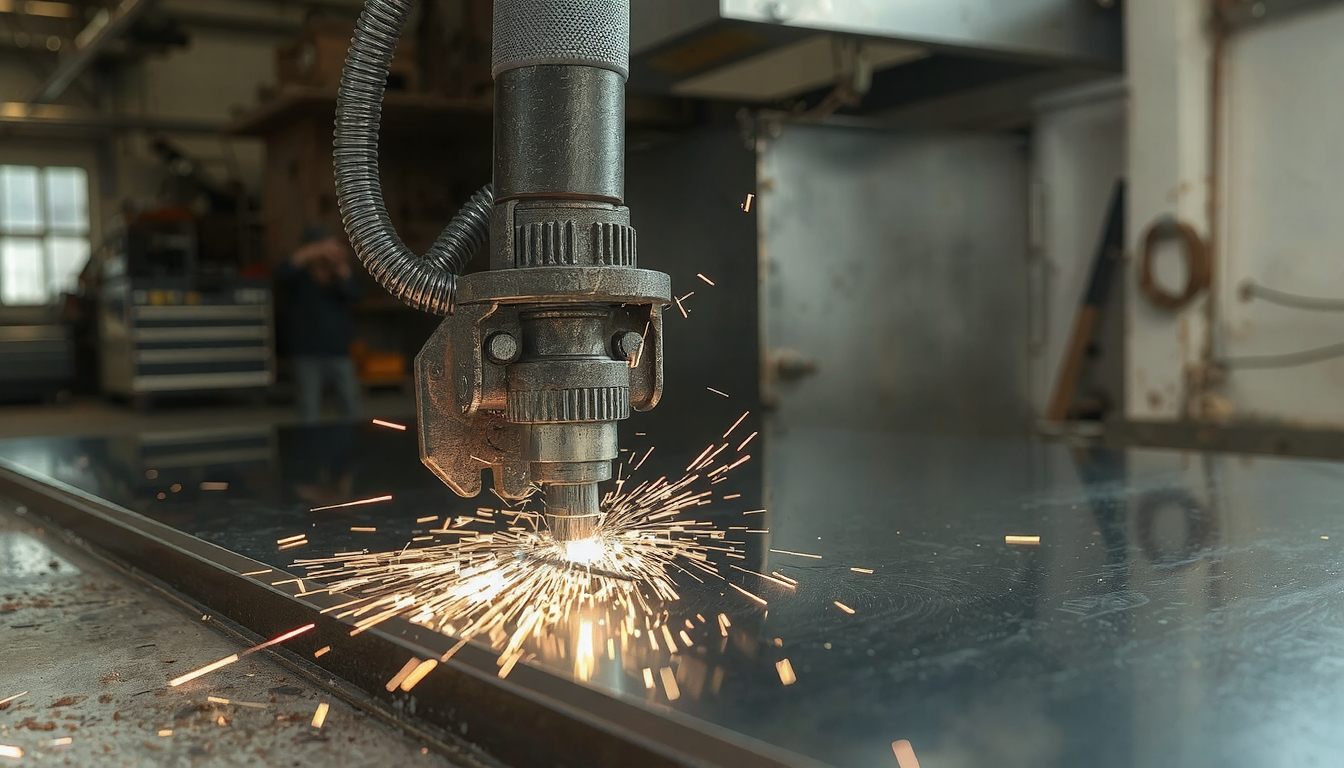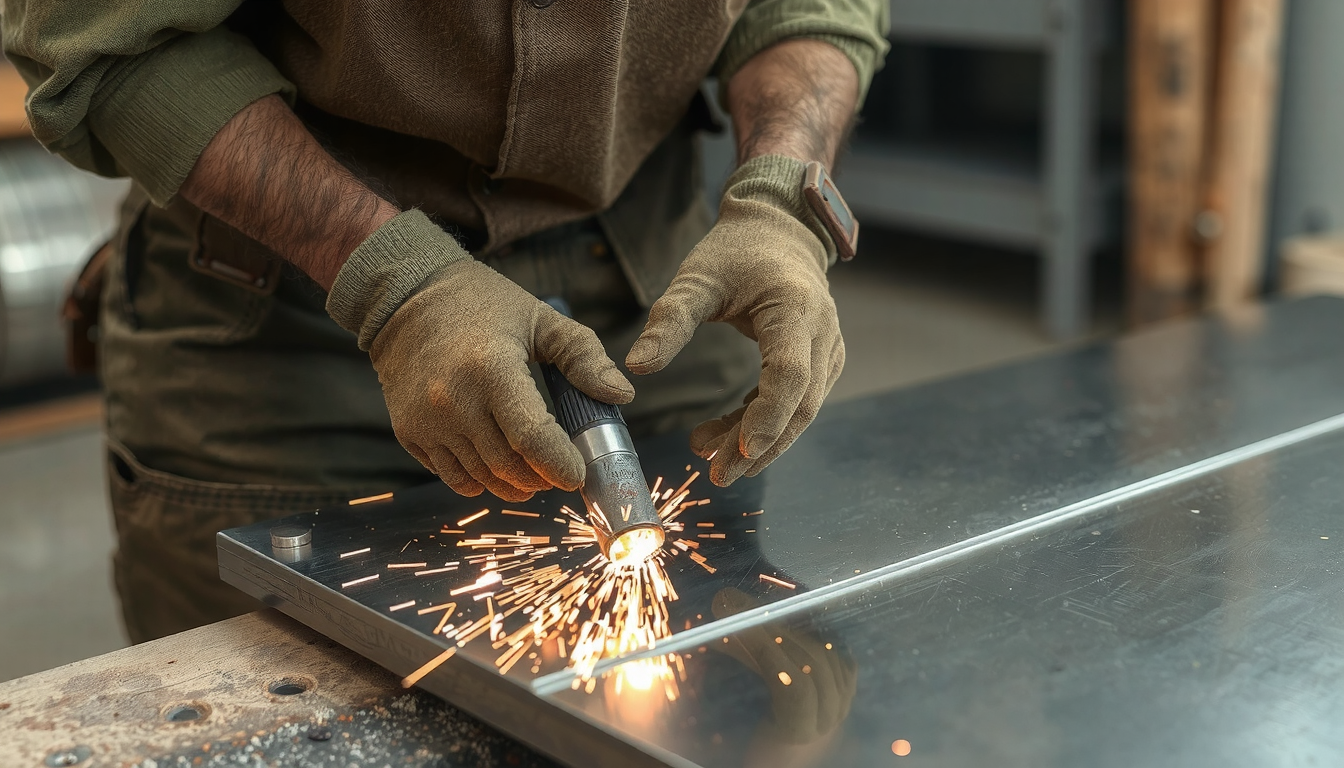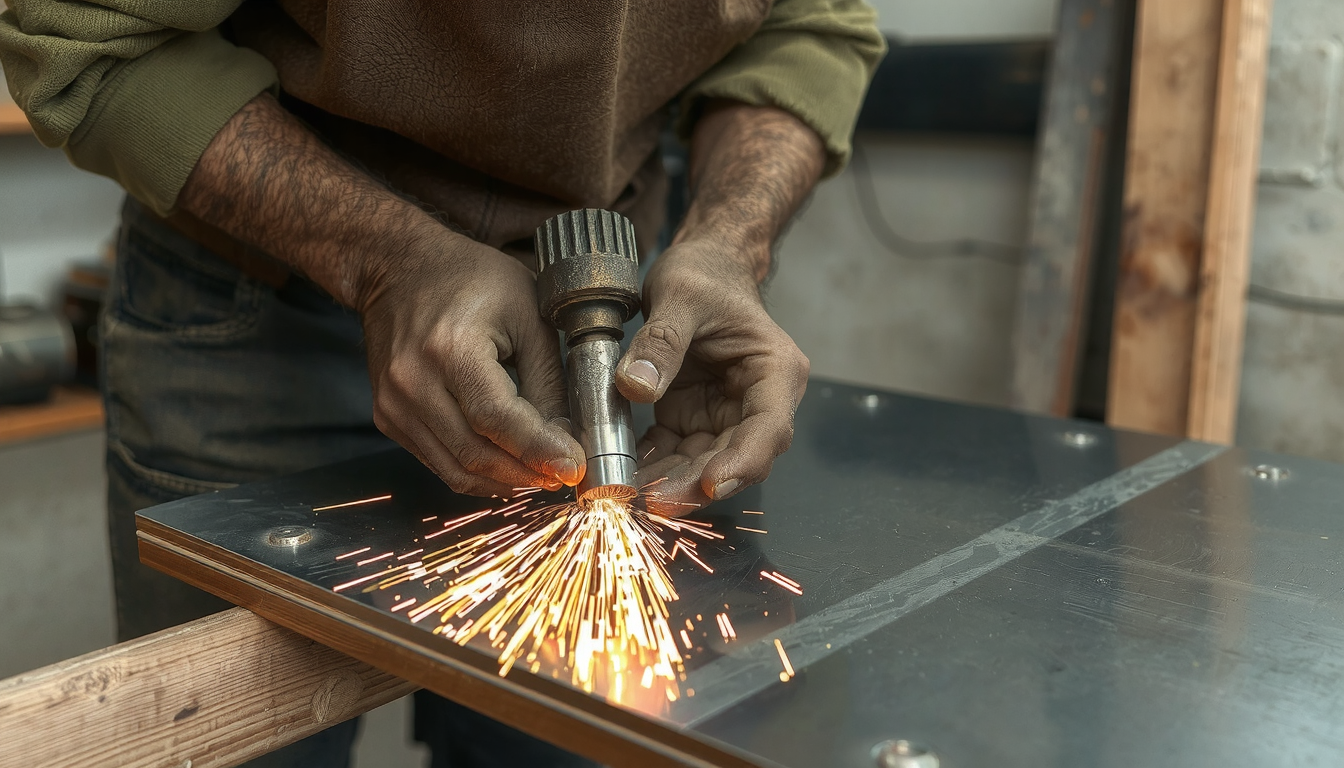Cutting stainless steel sheet metal might seem hard. But you can get clean, exact results every time with the right tools and steps. You have found the right guide to help you do it.

Stainless steel is tougher than regular mild steel for two main reasons. It gets harder as you work on it. This process is called work-hardening. It also holds onto heat. This can dull your tools and warp the metal. Knowing how to deal with these issues is the key to success.
This guide will show you how to cut stainless steel sheet metal safely and cleanly. We will cover safety checks. We will also talk about picking the best tool. You’ll learn step-by-step methods and how to get a pro finish. At Mekalite, we work with metals every day. We’re sharing our expert knowledge to help you succeed with your project.
Before You Cut: Essential Prep and Safety
Good preparation is the most important step for a great result. It also keeps you safe. Before you even think about how to cut stainless steel sheet metal, you must get ready. You need your gear, your metal, and your workspace prepared.
Your Must-Have Safety Checklist
Working with metal creates sharp edges, dust, and sparks. Always protect yourself. This list is not optional.
- Eye Protection: Wear safety glasses or a full-face shield. This is a must.
- Hand Protection: Use heavy-duty, cut-resistant gloves. These help you handle the sheet and protect from sparks.
- Hearing Protection: Use earplugs or earmuffs. This is especially important when using loud power tools like an angle grinder.
- Respiratory Protection: A good respirator mask keeps you from breathing in harmful metal dust.
- Proper Clothing: Wear long sleeves and pants made from cotton or leather. These materials won’t melt or catch fire easily from sparks.
Preparing Your Stainless Steel Sheet
A little prep on the metal itself makes a big difference.
First, measure your cut lines with care. The old rule “measure twice, cut once” is very true here. Use a fine-point permanent marker. Also use a quality square or straight edge for exact lines.
Next, clean the metal surface. Use a cloth and a simple cleaner to wipe away any oil or dirt. A clean surface helps you see your line. It also prevents your tool from slipping.
Many sheets have a thin plastic film. You can leave it on to protect the shiny finish from scratches. But with high-heat tools like a grinder, this film can melt and make a mess. For these tools, it is better to remove the film along the cut line.
Securing Your Workspace

Your work area must be solid and stable. A shaky table will lead to a bad cut.
You must clamp the sheet metal down firmly. This stops the metal from vibrating or moving while you cut. Vibration can ruin your cut. It can break your blade and is a major safety risk. Use several strong clamps on a sturdy workbench. As experts point out, it is critical to secure your sheets properly to prevent accidents and ensure a clean cut.
Choosing Your Weapon: A Comparison of Cutting Tools
There is no single best tool for every job. The right choice depends on the metal’s thickness. It also depends on the type of cut you need and your budget. This section helps you choose the perfect tool for your project.
Understanding the different methods for cutting stainless steel will save you time and money.
Tool Selection Matrix for Cutting Stainless Steel Sheet
| Tool | Best For (Thickness/Type) | Cut Quality | Speed | Cost / Access | Pro Tip |
|---|---|---|---|---|---|
| Angle Grinder | Thin-Medium (up to 3mm), Straight/Rough Cuts | Fair to Good | Fast | Low | Use a thin (1mm) cut-off disc made for stainless steel (INOX). |
| Jigsaw | Thin (up to 1.5mm), Curved/Complex Cuts | Good | Slow | Low-Mid | Use a bi-metal blade with many teeth (high TPI) and a slow speed. |
| Circular Saw | Thin-Medium (up to 3mm), Straight Cuts | Good | Fast | Mid | Must use a special metal-cutting blade, not one for wood. |
| Tin Snips | Very Thin (<20 gauge/~1mm), Short Cuts | Fair (edge curl) | Manual | Very Low | Color-coding shows cut direction (green=right, red=left). |
| Plasma Cutter | All Thicknesses, Any Shape | Excellent | Very Fast | High | The best for speed and any shape, but a big investment. |
| Shear | Thin-Medium, Straight Cuts | Excellent | Very Fast | High | Gives the cleanest cut with no heat, but is an industrial tool. |
How to Cut Stainless Steel Sheet Metal: Step-by-Step DIY Methods
Now we get to the main event. Here’s how to cut stainless steel sheet metal with common tools. For each tool, we will cover the right blade. We’ll also talk about the correct machine settings and the best technique.
Method 1: Using an Angle Grinder
An angle grinder is a powerful and fast tool for straight cuts.
- Blade/Disc Selection: You must use a thin abrasive cut-off disc made for stainless steel. Look for the “INOX” label. A thin disc, about 1mm or 1/16 inch, cuts faster and creates less heat.
- Machine Setup: Ensure the disc is tight and the safety guard is in place. The guard protects you from sparks and pieces of the disc if it breaks.
- Cutting Technique: Let the tool do the work. Do not push down hard. A common mistake is using too much force. This builds up heat, burns the metal, and wears out the disc fast. Use a steady, smooth motion to guide the grinder along your line. The sparks will fly behind the tool. So position yourself to the side, not directly behind it.
Method 2: Using a Jigsaw
A jigsaw is your best choice for cutting curves or detailed shapes.

- Blade Selection: Use a blade made for metal, not wood. A bi-metal or carbide-tipped blade will last longer. For thin stainless steel, choose a blade with a high “TPI” (Teeth Per Inch). A TPI of 20-24 is good for sheets around 1mm (20 gauge). A lower TPI works for thicker material.
- Machine Setup: Set your jigsaw to a low speed. High speeds create too much heat and will quickly dull the blade. Also, turn off the “orbital action” or set it to zero. Orbital action makes the blade move forward and back. This is great for wood but causes rough edges and blade wander in metal.
- Cutting Technique: Applying cutting oil or another lubricant to your cut line is a great idea. It reduces heat and helps the blade cut smoothly. It also makes the blade last much longer. Move the saw forward with steady, gentle pressure.
Method 3: Using a Circular Saw
A circular saw with the right blade can make very straight, clean cuts in stainless steel sheet.
- Blade Selection: This is crucial. You cannot use a wood blade or a masonry blade. You must use a blade made for cutting ferrous metals or specifically steel. These blades have many small, strong teeth and turn at a lower speed.
- Machine Setup: Make sure the blade is installed correctly. Set the cutting depth so the blade goes just slightly through the metal sheet.
- Cutting Technique: This method creates a lot of hot, sharp metal chips. A full face shield is absolutely required. Clamp the sheet on both sides of the cut line. This prevents the piece you cut off from vibrating, binding the blade, or kicking back at you. Guide the saw smoothly and do not force it.
Troubleshooting: How to Fix Common Cutting Problems
Even with the right approach, you might run into issues. Here is how to solve the most common problems when learning how to cut stainless steel sheet metal.
Problem: The Cut Edge is Burnt and Discolored
- Cause: Too much heat. This blue or brown color is a sign that the steel got too hot.
- Solution: Slow down your cutting speed. Make sure your blade or disc is sharp and designed for stainless steel. Use a cutting lubricant to keep things cool. On long cuts, you can stop for a moment to let the metal cool down.
Problem: My Blades or Discs Wear Out Instantly
- Cause: Work-hardening. The friction and heat from cutting make the stainless steel right at the cut line much harder.
- Solution: Use the correct blade material (cobalt or carbide for saw blades). Maintain steady forward pressure without pushing too hard. Never let the blade spin in one spot without cutting. This quickly hardens the steel and dulls the blade. Lubricant is your best friend here.
Problem: The Sheet is Warped or Buckled After Cutting
- Cause: Heat distortion. The heat from cutting makes the metal expand. When it cools, it shrinks and pulls the sheet out of shape.
- Solution: Choose a cutting method that creates less heat, like a jigsaw on low speed. If using a grinder or circular saw, try making a series of short cuts instead of one long, continuous pass. Also, make sure the sheet is clamped very well on both sides, close to the cut line.
Professional Cutting Methods for Ultimate Precision
For some projects, DIY methods might not be enough. Professional cutting services offer amazing precision for complex jobs.

Shearing
Shearing is like using a giant pair of scissors. It makes very straight, clean, and fast cuts with no heat or burrs. As explained in The shearing process in sheet metal, a machine uses two blades to slice through the metal. It is perfect for cutting large sheets into smaller rectangles.
Laser, Plasma, and Waterjet Cutting
These are computer-controlled (CNC) methods that can cut any shape you can imagine.
- Laser Cutting uses a powerful, focused light beam for very precise cuts with a clean edge.
- Plasma Cutting uses a jet of hot gas to melt through the metal. It is very fast and great for thick steel.
- Waterjet Cutting uses a high-pressure stream of water with a fine abrasive mixed in. It cuts with no heat at all. So there is zero risk of warping.
When to Hire a Professional
If your project has complex curves, is made of thick material, or needs a perfectly finished edge right from the cut, hiring a pro is a smart move. For projects that need the highest accuracy, consider a professional sheet metal fabrication service. While sheet cutting deals with flat stock, other projects may require precision-machined components from round stock. This is a task perfectly suited for CNC lathe services.
The Final Touch: How to Deburr and Finish Your Cut Edge
No matter how you cut it, the new edge will be very sharp. It will also have small, rough bits of metal called burrs. Removing these is a critical safety and finishing step.
A raw cut edge can easily cause a serious injury. Always deburr and finish the edges to make your project safe and professional.
Deburring Tools and Techniques
- Hand File: The most basic tool. Use a flat or half-round file. Push the file along the edge in one direction, away from your body.
- Deburring Tool: This tool has a small, swiveling blade that follows the edge. It is much faster than a file for long, straight edges.
- Flap Disc on an Angle Grinder: For heavy burrs, a flap disc (like a sandpaper wheel) on a grinder works quickly. Use a light touch and keep the grinder moving to avoid taking off too much material.
Restoring the Finish
If you scratched the surface near your cut line on brushed stainless steel, you can often fix it. Gently rub the area with a fine-grit abrasive pad (like a Scotch-Brite pad). Always rub in the same direction as the original brushed “grain” to blend it in.
Frequently Asked Questions (FAQ)
What is the easiest way to cut thin stainless steel sheet metal at home?
For very thin sheets (under 22 gauge or ~0.8mm), a good pair of aviation snips (shears) is often the easiest and quietest method for straight or curved cuts. It may cause a slight curl on the edge. For slightly thicker sheets up to 1.5mm, a jigsaw with a metal-cutting blade offers the best mix of control and ease.
Can I use a Dremel to cut stainless steel sheet?
Yes, you can use a Dremel or another rotary tool with a reinforced abrasive cutting wheel. However, this is only good for very small, short cuts or detailed shapes on thin material. The small discs wear out very quickly and create a lot of heat. So it is not a good choice for long cuts.
Do I need a special blade to cut stainless steel?
Absolutely. Stainless steel is very tough and needs blades made for it. For jigsaws or circular saws, look for bi-metal or carbide-tipped blades. For angle grinders, you must use abrasive discs that say “For Stainless Steel” or “INOX” on the label. Using the wrong blade will give you a poor cut and will be ruined quickly.
How do I cut a hole in the middle of a stainless steel sheet?
The best tool is a hole saw made for metal. First, drill a small pilot hole for the center guide. Then, using a drill on a slow speed with firm pressure and cutting fluid, use the hole saw to cut the circle. For square or odd-shaped holes, drill a starting hole in a corner and use a jigsaw to cut along your lines.
Why did my stainless steel turn blue when I cut it?
The blue color is from heat. It’s a sign that the steel got too hot while you were cutting. This usually happens from too much speed, a dull blade, or pushing too hard. It is mostly a visual issue. But it tells you to slow down or use a cutting fluid to keep the metal cooler.

